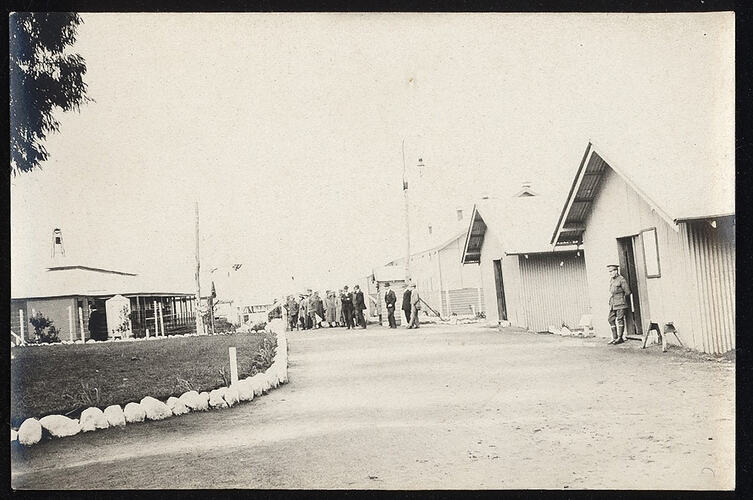Summary
Photograph of the main entrance to Langwarrin hospital (aka camp), depicting huts and grounds, during World War I.The same scene is depicted in a World War I image at the Australian War Memorial, which describes it as 'The entrance to the camp at the Venereal Hospital at Langwarrin, Victoria'. The photograph belonged to Miss Elsie Storie of Brunswick, later of Canterbury, a young woman during World War I. She visited the site on Christmas Day in 1917, and was one of many to sign a menu on the occasion (HT 8455).
The Langwarrin camp area was used early in World War I for 'enemy aliens' and later as a hospital for the treatment of soldiers suffering sexually-transmitted diseases. During World War I, Australian forces during World War I were vulnerable to sexually-transmitted diseases: many on their first adventure away from home, facing an uncertain future or even death, and liberated (at least in part) from the social norms of home. Loss of troop time through STDs during World War I was considered significant: early in 1915, 1000 AIF men were infected at any one time - the equivalent of a battalion at full strength. The official historian of the army in World War I, Arthur Graham Butler, noted that 'in none of the forces from the dominions, serving overseas, far from their homes, of which figures are available, was the proportion of admissions to hospital for venereal treatment less than 100 to every 1000 soldiers.' Returning to Australia due to sexually-transmitted disease was considered a disgrace. Venereal patients sent home were typically treated at the 'isolation camp' at Langwarrin. By the war's end over 6000 men had passed through the camp.
Part of a collection of paper-based ephemera relating to the life of Miss Elsie Storie, a middle-class Melbourne woman who was born around 1895, lived through both wars, and remained in Melbourne all her life.
Description of Content
The grounds of a military camp. There is a road running through the middle of the image, on the right side of the road are two huts - there is a soldier standing guard at the door of the closest hut. On the left side of the road is a grassed area with rocks lining the edge. Further in is a large building with a crowd of people in front, some are wearing formal attire.
Physical Description
Black and white silver gelatin photograph on paper.
More Information
-
Collecting Areas
Images & Image Making, Migration & Cultural Diversity, Public Life & Institutions
-
Acquisition Information
Donation from Mr John Millward, Mrs Millward, 2007
-
Place & Date Depicted
-
Previous Owner
-
Format
Photograph, Black & White
-
Inscriptions
Hand written in grey pencil on the back of the photograph; '30'
-
Classification
-
Category
-
Discipline
-
Type of item
-
Image Dimensions - Photograph
80 mm (Width), 54 mm (Height)
-
References
Arthur Graham Butler, Official History of the Australian Army Medical Services, 1914-1918, Volume III - Special Problems and Services, p.148+ Raden Dunbar, 2014. The Secrets of the Anzacs, Scribe, Melbourne
-
Keywords
Military Camps, Sexually Transmitted Diseases (STDs), Internment Camps, Huts, Crowds, World War I, 1914-1918

